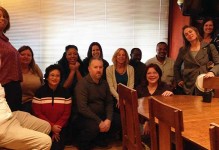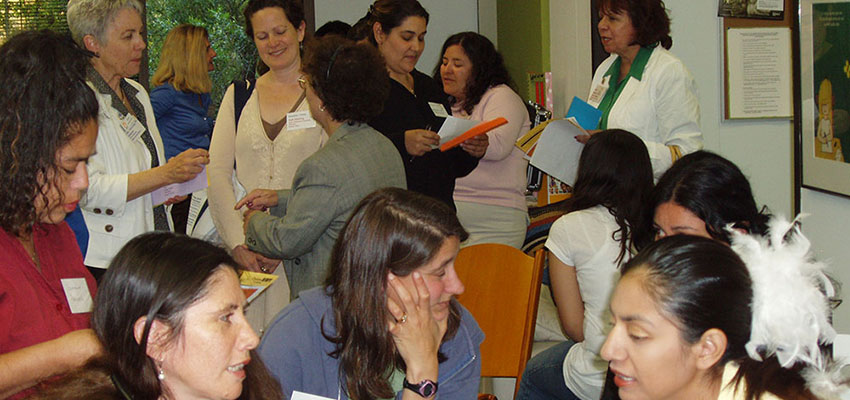As an Interim Executive Director, I am often faced with suspicious and concerned staff depending on how the departure of the previous executive director or CEO was handled by the board. Even in the best of situations, the loss or departure of the chief executive causes difficulties. It is natural to try to resist something you are not familiar with. In organizations undergoing change, resistance is to be expected. What people are resisting isn’t necessarily the change they are experiencing; they might even be welcoming the change. What they are resisting is the having to “let go” of things that they have always done or situations that they have depended upon, sometimes for years. It’s a sense of loss. Resistance is neither avoidable nor bad. It is a fact of organizational life especially during transitions. By showing resistance, employees are struggling with the dismantling of both their individual and collective worlds, or those circumstances and perspectives that have helped them to feel at home while at work. Resistance becomes the “system’s” effort to regain the equilibrium that has been disrupted by the change.
As consultants working in the area of executive transitions, we must allow people time to experience the changes at their own pace and provide them with support and understanding along the way. Consultants often err on moving too quickly, expecting employees to “tough it out.” Then when anger or resentment happens, or staff withdraw and under-perform as they mourn the loss of how it was, the consultant takes it as a personal challenge to his or her authority. Good transition managers and consultants provide good, clear information about what can be let go of (we don’t have to have two check-in meetings each week anymore) and what can be saved (your style of running staff meetings really works), will help employees better understand the value of the change, not get stuck in the past, and begin to think about what lies ahead. Managing the feedback and the communication contained in resistance is critical to creating effective work partnerships with employees. Regular and honest communication about the change is key!
Resistance takes many forms. In some instances, resistance can provide valuable feedback for transition leaders and consultants. This feedback can be experienced as:
- Denial
- Lack of Motivation/underperforming
- Incompetence
- Skepticism
- Questioning the skills or credentials of the transition leaders
- Pessimism
- Impatience
Sometimes the causes of the resistance are very helpful for building effective strategies for responding to employees in ways that can further build partnerships and teams. Causes of resistance can include: preserving what is presently valued; feeling out of control; threats to dignity, respect, and autonomy; fear of job loss or reporting structures, struggles over power and control, just to name a few.
Certain qualities of resistance stand out amongst all the rest:
- Direct and active vs. indirect and passive
- Flexibility vs. rigidity
- Situational vs. chronic or systemic
If resistance gets out of control it is usually because it has lost contact with its original cause and points to larger organizational issues that may run deeper than dealing with the current change. For instance, there may be a history of mistrusting management or undermining key functions or positions. There might have been favoritism, nepotism, or lack of clear operational policies and procedures. In these cases, it would be important to trace the origins of the problem before you can get a handle on the resistance you are facing. Gaining input across all departments would be important to do, before any organization restructure occurs or actions can be taken.
In order to effectively address resistance, a transition manager must not only anticipate resistance, he/she must be willing to explore the feedback the resistance is providing, and form the needed partnerships with employees to address what is happening. Only then will employees feel able to express their sense of loss or fear and feel validated and understood, thus empowering them with the tools to effectively deal with the changes they are experiencing. When this occurs, true problem solving begins and a representative Transition Team can be formed that works toward the new (and hopefully positive) “New Beginning” that come with change.
Thanks to Barry Dym, PhD and William Bridges, PhD for their valuable writing and inspiration on this subject. Beth Schecter is a transition consultant in the San Francisco Bay Area. 415.609.3548
Premise: Leadership continuity and managing leadership changes* are critical components of nonprofit success that require time and attention.
“The Interim ED/CEO provides this opportunity for Boards to quickly learn the inner workings of a nonprofit. Boards can decide to use this expertise to gain new intelligence about their organization or they can stumble through the transition time with blinders on, rushing to the finish line like a racehorse, looking neither right or left.”
As a consultant who provides interim transition services to nonprofits, I have recently had some shorter positions as the Interim CEO following a long-term CEO. These were well-established CEOs who were respected for their work. The boards had been very dependent on them for many things, including fundraising and community relations and engagement. In one situation, I stepped into a large deficit that only fundraising could close since the majority of funds came from stable government contracts. In the other, the CEO had been negligent of the often boring infrastructure and policy updates needed to keep a nonprofit healthy and stable. These situations required some work… which required some time.
In my role as a transition specialist stepping into the CEO position when there is a vacancy, I need time to get the lay of the land and report this to the board. My assessment report is presented in a thoughtful and compassionate way, keeping emotion out of the equation. Usually the board is grateful for this reporting and for a fresh pair of eyes looking at the situation. Occasionally the board, who has been complicit (or kept unaware) with the CEO in maintaining an unhealthy status quo, and can be defensive of the findings and just want to move quickly to hire the next “victim,” I mean CEO, and not have to change anything. I find this occurs more often when board terms are not followed (or there are none) or board officers have stayed in positions for many years. Change and new perspectives are not always welcome. It is this scenario that leads me to feel the most rushed and challenged. Rushed might mean four or less months of work.
Four months or less requires laser focus and a bigger push than staff might have expected or be capable of doing during the transition, and can create a sense of panic and anxiety. In some cases, the staff are perfectly happy being behind the times and are even accepting of the status quo. But once they understand the implications of what hiring a younger or different, creative thinker as their CEO and the clean-up that is required to prepare for new leadership, they often get energized to work towards a positive new beginning. If this understanding is not achieved, the new CEO could quickly get disillusioned and might seek employment elsewhere within a year or two. It also sets the wheels in motion for change, which will be inevitable once the new CEO starts. The staff can begin to embrace the cycle of transition and with the right framing around the transition specialist role, can actually enjoy it. This can be an exciting and creative time of quality improvement and personal growth for the staff and leadership, including the board. It sets the stage for a more successful leadership transition that the legacy nonprofit needs if it is to keep current, create more internal energy and ultimately, gain better mission results.
Here is how I approach these shorter transition management and change initiatives:
- Present the truth of my findings to the board and create a plan of action that encompasses 90-120 days as quickly as possible (some of which the new CEO will complete).
- Define the role of an active leadership team in making sure the organization gains traction during this very special and unique transition time.
- Focus on 4-6 key initiatives agreed upon by the board and staff team as essential for moving the organization forward and for preparing for a new, and more energetic leader.
- Review transition management with the entire staff and the critical role each person plays in preparing the team for a positive New Beginning.**
- Set short term goals for myself and the leadership team with deadlines and small wins.
- Share the results of the work with the board, making sure the Leadership Team is aligned and supportive.
This approach frees the board to work with a search firm to find their slate of candidates for the CEO position. I often provide my findings to the search firm as well so we don’t duplicate efforts and they have current information about the organization’s status. This information leads to a better definition of CEO qualities the board is seeking, such as, internal or external facing, more detail or fundraising‐oriented. It also defines the board skills needed to govern the organization.
As an experienced Interim CEO, I can move quickly through the analysis of how the nonprofit is doing, having stepped into more 15 transitions, but newer consultants will need more time for good results. Boards have to decide if they want to use the transition to take a step back and gain a deeper understanding of the organization, from the inside out. The Interim CEO provides this opportunity as they are in place several days a week and quickly learn the inner workings of the nonprofit. Boards can decide to use this expertise to gain new intelligence about their organization or they can stumble through the transition time with blinders on, rushing to the finish line like a racehorse, looking neither right or left.
My suggestion to Boards: give the transition at least 6-9 months and feel comfortable that the experienced transition specialist has valuable information to share about their nonprofit, nonprofit sustainability, and trends in general. Hiring an exceptional transition specialist who keeps current and is highly recommended by trusted colleagues is critical. Then, relax and trust the Interim will do what is best for the organization based on their expertise.
Boards can do a great service to their organization by taking advantage of a leadership transition for true reflection on the state of the organization. This can be followed by a set of actions designed to move the organization to a greater state of preparedness for a new CEO. The combination of being well-informed and a willingness to slow down and make some changes will provide a more stable and open environment for a new CEO to be more successful in the future.
*Executive Transition and Leadership Continuity includes elements of change management and succession planning
**Utilizes the framework of Transition Management by William Bridges, PhD
Congratulations! You have made a decision to engage the services of an Interim Executive Director (Interim ED/CEO) during your organization’s leadership transition.Transitions are powerful opportunities to strengthen nonprofit organizations. Properly managed and supported with expert executive transition services, they can serve as “pivotal moments” enabling organizations to change direction, maintain momentum, build or rebuild its infrastructure, and clarify its mission and vision. Poorly managed executive transitions incur high costs to organizations and communities.
I have prepared this document as a guideline for what you can expect during my tenure.
The Evelyn and Walter Haas, Jr. Fund and the Annie E. Casey Foundation have made substantial investments in developing the field of practice associated with executive transition management. This has continued through the Alliance for Nonprofit Management. Research has identified the use of Interim Executive Directors/CEOs as a powerful capacity-building strategy for Nonprofits who want to turn their leadership transition into a time for gaining a deeper understanding of organizational improvement and learning, leading to sustained mission results.
My goal as an Interim ED is to be as clear and supportive as possible with the Board of Directors and staff in order to achieve a sustainable leadership succession that is strategic and aligns with the overall mission.
The Interim ED manages the day to day operations of the organization and supports the Board of Directors in carrying out the nonprofit’s business. Given the interim role and tenure is more limited than the Executive Director, not all responsibilities are carried out with equal attention, but each is equally important. Together with the Board and staff, we establish top priorities. Duties often encompass:
- Financial management
- Fundraising/Resource Development
- Boardfunctioning/governance
- Staffing structure/infrastructure/staff development
- Program operations/contract management
- Culture and communications
- Strategic plan/business plan/business model
- Major events and organization calendar
- Executive Director search and onboarding (assist the Board if needed)
- Specific goals and workplan for 6-12 month transition period
Key Transition Actions for First Two - Eight Weeks of the Interim Executive Director Tenure
The first several weeks is a critical time for clarification and communication with the Board, management/leadership team, and staff in order to insure alignment with the Interim ED roles and responsibilities. Primary tasks include:
- Meet with the Board members responsible for the transition to gain their perspective on the current status of the organization and to orient them on how best to utilize an Interim ED. As requested, speak to other key stakeholders and staff in order to collect data on organization standing.
- Review all internal documents (proposals, reports, Board minutes, contracts, evaluations) to gain a thorough grounding of process, procedures, history and current status.
- Gain understanding of the following:
- Timing and reason for ED departure
- Organizational dynamics (staff culture and morale, board operations)
- Strength of Leadership Team
- Financial health
- Fundraising status: on target? expectations for year?
- Major events during Interim ED tenure: gala, proposals, reports, audit?
- Core capacity building needs to address (see chart below)
- Top priorities, deliverables and deadlines
- Interview the departing ED for perspective and priorities. Gain the calendar for the year.
- Stabilize the organization, acknowledging the unique nature of the transition time.
- Develop a work schedule and open door policy.
- Acknowledge and monitor loss/grief and change concerns. Help staff with transition.
- Get to know Leadership Team and gain understanding of their work priorities and concerns.
- Visit all program sites and observe programs in action.
- Review all key financial documents.
- Develop a work plan with performance goals and objectives based on discovery findings.
- Gain a deep working knowledge of all of the below capacity areas:
Ongoing Transition Actions During the Interim Executive Director Tenure
- Work closely with staff and review performance goals and expectations.
- Meet regularly with Leadership Team to build a cohesive and accountable team.
- Carry out all programmatic needs.
- Keep Board on track, provide regular monthly reporting.
- Relationship building with stakeholders/donors/funders with periodic updates.
- Continue to work with staff and Board to envision the future and how they want things to be different (or similar) under new leadership.
- Continuously review Interim ED workplan and performance goals to insure relevancy.
- Serve as a consultant for search committee/search consultant as requested.
Ongoing Communications Provided by Your Interim Executive Director
Communication is the name of the game during a transition. It is important to clarify the type of communications expected from your Interim ED. Here are some samples of written and in-person communications I provide:
- Interim ED Discovery Report of Findings at first or second Board meeting based on initial internal review and discovery meetings.
- A custom workplan with performance goals and top priorities.
- Monthly report to the Board of Directors via the Board packet and through other email updates.
- Weekly check-in with Board chair; monthly Board meeting; other committee meetings throughout the month (typically finance, development and governance).
- Bi-Weekly check-in with staff Leadership team; weekly supervision of direct reports; monthly all-staff meetings.
- Final Report and closing recommendations and items to be handed off to new ED.
Important Underlying Principles of Organizational Transitions
(Adapted from the work of William Bridges)
When there is a shift in executive leadership, organizations experience many new and often unexpected challenges. Transition research has shown that awareness and understanding of the transition process can benefit all staff and Board members in maintaining a positive outlook about these changes. It can also better prepare the organization for its next phase of leadership. In addition, a new Executive Director entering an organization will have an easier time adjusting and being successful if the organization has done this preparation and has high levels of optimism about the future.
Some important concepts about transitions:
√ Change is the objective event: loss of Executive Director; new Executive Director is hired.
√ Transition is the psychological process of reorientation as a result of the change(s).
√ Transitions must be well managed or change becomes unmanageable.
√ Transitions include three overlapping phases consisting of:
- An Ending Phase – gaining closure on the executive’s departure;
- A Middle Phase or the Neutral Zone - a time of organizational vulnerability, and importantly, of heightened opportunity; and
- A New Beginning Phase – includes the new executive’s welcome and onboarding, partnered with significant organizational changes and new ways of doing business.
As an Interim Executive Director, I maintain awareness of these principles throughout my placement. I watch for behaviors and actions that might be the result of anxiety often associated with change and I work with staff to alleviate and normalize concerns. I also embrace the positive aspects of change, focusing on staff and organizational strengths and preparing for the new Executive Director.
I am never a candidate for the Executive Director position as a means for establishing an objective and open perspective on organizational life and health often revealed during a leadership change.
Let’s Get Started!
What happens when the CEO leaves, voluntarily or not? Everyone panics!
But what if you could turn to a seasoned executive who knew just what to do to keep things chugging along while building a more sustainable organization at the same time?
That’s what I do – I’m an Interim Executive Director and CEO for nonprofit organizations. I have served the nonprofit community for 30 years and I now give back in a different sort of way to ensure the sector gets stronger.
No, I’m not a hero, but as an experienced consultant, I shift quickly into the role of Interim Executive Director or CEO when the nonprofit loses its top leader due to resignation, retirement or termination. For 6-12 months, I provide the board with the time and space required to step back from their concerns about the leadership change and carefully search for the new permanent successor. While the search is going on, I’m the Management Consultant, doing what I can to help the organization thrive and build sustainability. My 30 plus years as a nonprofit executive gets put to work to make improvements and share best practices while working closely with staff to ensure everything gets done and that no opportunities are missed. I have a keen sense of strategy and apply my knowledge at this critical juncture of leadership change. I take a deep look at the fundraising, grants, community relations, earned revenue, financials, staffing structures, technology needs, and more. Within 6-8 weeks I have a pretty good assessment and set of critical tasks to present to the board. Once we agree, then, voilà, there is my workplan for the next 30-120 days or more.
It’s not easy. Often there are many snags, some inherited and some revealed. But I stay calm, and reassure the staff and board, and keep going. Sometimes I serve as a Change Agent if the issues are intractable and merger might be in order. Sometimes the organization might have to close. But overall, I am able to provide some high quality transition leadership and change techniques throughout the entire time. As a Transition Consultant, I talk about transition a lot to anyone who will listen – for example, what it means and feels like to be in this unknown territory. I talk about the future and what a new beginning might look like. I talk about what we can do together as a staff and board to achieve a positive outcome. I make sure everyone counts and each person is participating.
I also have a special trick up my sleeve. I belong to a community of practice of other consultants serving the nonprofit community in the same way I do. We meet regularly, share resources, seek advice, and solve problems together. I might even bring one in to help co-lead at a critical juncture. Our group, the Bay Area Interim Executive Directors Network, or BAIED, supports our Bay Area nonprofit community during its critical transition times so the shift from previous Executive, to Interim Executive, to new Executive can be successful.
My advice to the nonprofit community: Leadership transitions can be difficult, but you can avoid the chaos by hiring an EXPERIENCED and TRAINED Interim Executive Director/CEO to be your transition coach, management consultant and change agent during this critical time. It’s an approach to nonprofit change that really works!
Contact me to find out more about Interim Executive Director work and the Bay Area Interim Executive Directors Network.
Download a PDF of this blog post here.
Turnover at the top can be painful. But it doesn’t have to be. As organizational expert William Bridges says “Change is an objective event- it happens. Transition is the psychological process people go through to cope with change.” Transitions must be well managed or change becomes unmanageable! Here are my ideas for making your leadership transition as smooth as possible:
- Select an excellent search firm that specializes in nonprofit searches and whose approach you agree with and trust. If your organization is an affiliate of a larger nonprofit, request there be a dedicated HR specialist from headquarters to assist you with your search.
- Hire an Interim Executive Director to stabilize and run the operations, freeing up the board to become fully engaged in the search process. Be sure the Board creates a Transition Committee responsible for championing the search.
- Take some time to analyze the “state of the organization.” You can do this with the help of your Interim Executive Director who is trained to look at every functional area and identify the strengths and weaknesses and determine what should be addressed before or after the new Executive Director is hired. Through this analysis, important information will be revealed that will enlighten the board about the traits and attributes sought in the new Executive Director. This will be useful for the crafting a relevant job announcement for the position.
- Post the position and work with your search professionals to carefully review resumes, hold interviews and ultimately make your decision. I always think it is a good idea to involve some of the management staff in the process as well, making it clear to the them that the final decision rests with the Board. Hopefully it will all go smoothly, but be prepared for it to take some time to find the right person. Once your new Executive Director is in place, your search professional and Interim Executive Director can help him or her acclimate to their new job by providing a plan and materials for onboarding. This will guarantee a smooth start and set the stage for a successful tenure.
Whether a long-term Executive Director is retiring, or there has been a termination or a resignation, the Interim Executive Director model, working closely with the search professional, gives the board and staff a chance to collectively catch their breath and take stock, sometimes for the first time in years, do some re-tooling, and move forward with renewed vigor. If this process is rushed, the new Executive Director might find that many of the unaddressed transition tasks are too daunting on top of everything else that needs to be done to run the organization, and might end up leaving the position before he should. This leads to an “inadvertent Interim,” something you hope to avoid.
J.R. Yeager, Project Director with Compasspoint Nonprofit Services and a great colleague, wrote this wonderful overview of how to best work with the Interim ED/CEO from the Board perspective (2/27/14). He has given me permission to share it here.
In the blog “Interim EDs: Making a Good Thing Work for You [2],” I wrote about the purpose and value added by engaging an interim executive director (ED) while you and other members of the Board of Directors step back and take some time to assess your organization’s current needs and prepare yourselves and the staff for working with a new permanent ED. In this post, I share my best advice on the Board’s role in this temporary relationship, focusing on how to partner with your interim ED and what to expect.
1. Interim means interim. Make it clear from the start (pre-hire, in fact) that the interim executive director will not be considered for the permanent position. Otherwise, you lose one of the most valuable attributes of the interim model: neutrality. A neutral interim executive will be more likely to “tell it like it is” and give you options to consider. If this isn’t made clear, the very worst case scenario (and I’ve seen it happen) is an interim who will spend more time jockeying for the permanent position than working on the issues she was hired to address.
A red flag: An applicant who states that she is “between jobs” and looking for a “new opportunity” might not be the right hire, as she may be viewing an interim position as a pathway to a new ED position and not for the specialized, time-limited role it really is. At the same time, if you hire an interim who’s really looking for an ED job and she happens to find a new position elsewhere while your organization is still in the middle of your interim trajectory, you could be left without a leader again. There are plenty of folks out there who understand the model and philosophy of interim management, so choose wisely.
2. Communicate your intentions. Let your funders, community partners, and even your clients know that hiring an interim executive was an intentional decision by your organization, not a fallback move. Make sure they know that the Board has deliberately set aside time to assess the organization’s operations and goals, to address short-term issues, and to ensure the best and most relevant program delivery before beginning its search. Communicate, communicate, communicate.
3. Stay engaged and be available. You’ve just put in the time and effort to find the best person to steer the ship, perhaps through choppy waters. This is not a time for the Board to look away. The Chair and/or Executive Committee should be willing and available to meet more often than usual with the interim until he is on solid ground. Talk to your interim and find out what would be most helpful for him. It may be as simple as a regularly scheduled Friday morning conference call to touch base, share updates, and/or problem solve.
4. Don’t shoot the messenger. Be receptive and open to possible bad news. Sometimes your interim may be the bearer of bad tidings, of information that may have been previously withheld, or of things you wish you had known about sooner. I’m painting a bleak picture with this point, but if you hire an interim because you just fired your permanent ED, or you are hoping the interim can pull off a major financial turnaround for you, then every day may not be rosy. So listen with empathy and remember it is your interim who is down in the trenches doing the hard work and taking the heat.
5. Allow adequate time for change to happen. Eliminating debt, restructuring programs, rebuilding the Board — these things don’t happen quickly. Create a timeline and revisit it with your interim often. It’s not unusual for interim EDs to be in their roles for nine months or a year. That’s OK if it is moving your organization toward the stability it needs in order to attract the right permanent ED. Flip side: Don’t let the interim period drag on (and on). You can’t stay in the interim period forever. At some point, you’ve got to do the hard work of recruiting and hiring your next permanent ED.
6. Hold your interim accountable (I can’t say this enough). You may feel so relieved that you’ve found an interim in your time of dire need that you are willing to overlook missteps. But part of staying engaged is making sure your interim stays on the right path. Hopefully, you’ve set specific goals for the interim and you’ve discussed them with him at the outset of the assignment. Those goals may shift and/or be re-prioritized throughout the interim period (and agreed upon during your periodic check-ins).
But keep your eye on your bigger goal of a stronger, more stable organization that sets your new permanent executive up for success. Track your interim’s performance and expect answers to your questions. Respect the Board/ED relationship and give your interim the rope he needs to do the job. At the same time, remember your interim is a contractor or part-time temporary employee who, in a short time, could do as much harm as good. Ask for, and expect, more information and updates than you might normally ask of your permanent executive.
7. If you’re part of the problem, be part of the solution. Be willing to hear and accept that the Board’s own performance might be lacking and don’t take offense; it’s a tough job that you have taken on in your off hours. A stronger Board means a stronger organization, so take advantage of this time to strengthen your own role. Whether it’s participating in a “Board 101” training to get everyone on the same page and using the same language, or working on your ability to be a better decision-making team, it all contributes to a stronger organization and a more rewarding Board experience for you in the future.
8. Don’t ask your interim to conduct the search for your permanent ED. Sure, your grants may be limited and you might have to piece together a less-than-ideal hiring process if you don’t have the funds to secure a search consultant, but remember that your interim already has her hands full. Conducting a thorough search and screening process is labor intensive and requires a set of skills that your interim may not possess. A better strategy might be to task your interim with finding funding to hire someone else to work with a Board committee and conduct the search.
9. Lastly, use this valuable time before you launch your search to reflect, ponder, and imagine the future you want for your organization and the community you serve. With every leadership change there are new possibilities. Are you interested in geographic expansion or contraction, new programs serving a new population, or venturing into fundraising territory where your former ED was uncomfortable going? Once you understand where you want to go, defining the skill set and characteristics of your next executive will not only be easier, but empowering and inspiring as well.
What has been your experience as a Board member working with an interim executive director? We invite you to share your stories in the comments section below.
JR Yeager is a project director with CompassPoint Nonprofit Services with twelve years of direct client experience in Executive Transition Management and executive search. JR also consults and trains in the areas of Succession Planning, Board Development, Interim Leadership, and also manages the placement of Interim EDs with CompassPoint’s transition clients.
Much of 2013 was dedicated to serving as Interim Executive Director of a specialty children’s services organization in Alameda County, East Bay Agency for Children (EBAC). With its large budget ($10 million) and numerous programs (school based mental health, family resource centers, after school programs, and community based treatment centers), EBAC is a busy place. Hallmarks of this important leadership transition included:
- Managing for growth due to new funding from the county health services (EPSDT) for added school-based mental health services; from the city of Oakland for a new family resource center at a downtown school, and from the state of California for a Covered CA (Affordable Care Act) outreach and education grant.
- Gearing up for accreditation by a national body (CARF) which involved numerous policy decisions and actions impacting many clinical and safety systems.
- Clarifying standards of care and implementing trauma informed treatment for children in a therapeutic nursery and in day treatment programs.
- Creating the first-ever fundraising plan and clarified donor expectations
- Codifying board governance policies and procedures
- Increased scrutiny of internal operations and infrastructure.
All of these activities were happening while the board and senior staff worked tirelessly with the executive search firm to hire the new Executive Director.
Transitions in executive leadership are both unique and taxing times in organizational life, opening many doors for improvement while closing doors on the past. From my perspective as the Interim Executive Director, these challenges can be viewed as welcome opportunities for improvement and it is my job to help the board and senior management become willing partners in this process. With EBAC, once we all settled in, we worked together to explore new directions for the agency. My ultimate goal during a leadership transition is to provide clear and consistent continuity of leadership so the new Executive can begin from the current point and not from some obscure point in the past.
The senior management worked diligently to insure things stayed on track with the programs while all of this was going on. Upon my departure, the board felt better positioned to be strategic leaders. Staff felt clearer about their priorities as well as the immediate challenges needing to be addressed.
I hope to keep in touch with EBAC to see how the new Executive Director is doing. I am confident we took many important transition steps throughout the year to insure the organization thrives under new leadership.
Utilizing an Interim Executive Director can provide a “pot of gold” for the organization, everyone feels wealthier with the advantage of a fresh, objective perspective and a new set of actions. Whether a long-term Executive Director is retiring, or there has been a termination, the Interim ED model, gives the board and staff a chance to collectively catch their breath and look around, sometimes for the first time in years, do some re-tooling, and then with renewed vigor, move forward.
In addition to my Interim Executive Director work, I was able to provide some important consulting time with other organizations. I would with an early childhood program at UCSF to review its progress and determine some possible new directions. I worked with a chemical dependency treatment provider in Santa Cruz to gain managed care/ health insurance contracts and renewals and add new programs to what insurance will cover. This can provide a consistent revenue source for many providers with behavioral health treatment programs. I also worked with a well-known Latino service provider in San Francisco to assess its board functioning and recommend improvements.
I continue to be passionate about the health and vigor of nonprofits and feel that after 25 years of serving this sector I have much insight to offer. I hope you agree.
Best wishes for a successful 2014.
I know founders sometimes get a bad rap but as Carrie Bradshaw might ask- “Where would we be without founders?” I spent most of my year serving as the Interim Executive Director at a founder lead organization in New York’s Hudson River Valley with some of the most renowned leaders and teachers in the field of mindfulness, contemplation and social change. Founders are driven with a passion to do things differently and they create new movements and bring fresh approaches to solving difficult problems.
This year I enjoyed working with founders at two organizations. In one case we eased the organization and its board away from its founders to its explicit goal of hiring professional and lasting leadership. Here is some of what I did:
- Involved the founders in important and appropriate ways (fundraising, board building, making connections, telling their story)
- Modeled effective leadership with the staff
- Created a collaborative leadership team,
- Involved the board in redefining its governance responsibilities, and
- Gained agreement on the attributes sought in their new Executive Director.
This process took months, but when the search began, the board was re-energized.
Meanwhile the staff worked tirelessly to insure the programs were productive, which produced a successful year for the organization, even with a leadership transition. As a result, all were prepared to embrace the new executive director when she arrived.
I start each new assignment by asking many questions of myself, before I even begin the discovery process – what can I offer that will be of help? How can I best empower and guide them through their transition and prepare them for the future? What is the right timing for introducing new solutions or ideas?
Then, through a thorough assessment leading to a custom workplan, I methodically model and practice various techniques of nonprofit management that have been most effective for me in my 20+ years of executive management, including:
- Shared leadership and accountable management teams,
- Collaborative decision making,
- Leadership development of department directors and associate EDs,
- Open and transparent communication with all staff and board, and
- Strengthening boards through board training and clear governance practices.
In my executive transition work I stay mindful of the phases of the engagement from start to finish and remind staff and board of each phase so there are no surprises. This steady approach has allowed me to enter and leave new situations causing as little trauma as possible. If you do interim ED work you understand that Interim ED work is sensitive work.
A small recent project was “off-boarding.” A thoughtful first time Executive Director was leaving her position and was concerned about how to effectively transmit her work to the yet to be hired ED.
We explored several steps to take and tools to be left behind to best prepare for a seamless transition. EDs have massive responsibilities and hold critical information about EVERYTHING. Transmitting this to the new leader is critical. We broke departments down into “buckets” in order to leave a history for the next person. We used a combination of:
- Detailed outlines describing the status of each department or function (staff, board, facilities and operations, fundraising, etc.),
- A calendar for year, “what happens, when,” and
- A narrative about important relationships to maintain.
These steps produced a set of transition tools that the new ED can refer to over and over again. Of course, cleaning out those pesky online files is a big must as well.
What struck me through this process was that off-boarding has its rightful place alongside on-boarding, especially when the ED departs before their replacement is hired or there is restructuring occurring.
- 1
- 2















